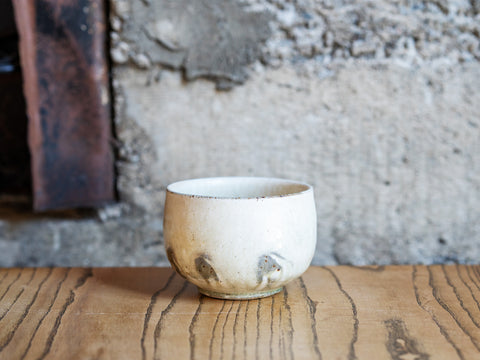Please view this YouTube video where Marco describes his design philosophy.
These winter bowls (chawan) were made by Marco Minetti of @minettidesign using Marco's reinterpretation of the "buncheong" style featured in our previous collaboration with Marco and Toroo Studio.
Each bowl is made from wild clay, slip, and various ancient and simple glaze combinations consisting of sustainably sourced almond wood ash, feldspar, and clay in different proportions.
Pictured from left to right:
- Ash Glaze (Green Hues)
- Crackled White Glaze (Glossy, Crackled Glaze)
- White Glaze (Semi-Matte)
- Shino Glaze (Red Hues)
Because each hand-made piece is one-of-a-kind, your bowl will vary in the amount of slip and glaze coverage on the exterior and interior. These bowls can be used for a variety of purposes. The wide, flat bottomed shape was designed to be the optimal size and shape for whisking matcha. Matcha is the most obvious use for this bowl, but it is equally enjoyable to use it to brew a whole leaf tea as you can watch the leaves slowly unfurl and contrast against the beautiful colors of the bowl. It can also be used as tableware, as a fruit bowl for example.
Marco Minetti trained in Korea under Kwak Kyungtae, a master potter from the apprenticeship lineage of Lee Kang Hyo and Koie Ryoji. He spent nearly five years living and working in a production studio as well as assisting the master in the making of large scale Onggi forms. Marco studied a 14th century slipware technique that originates in Korea, called Buncheong, later known as Kohiki in Japan and beyond. Years of production throwing along with dedicated daily practice of the Onggi method of making large (originally fermentation) jars by coiling/paddling have given Marco an intimate knowledge of Korean aesthetics, form, and technique. In 2018 Marco founded Ceramic Masterclass, an intensive cross cultural workshop located in Gyeonggi province, just an hour from Seoul. More info can be found at www.ceramicmasterclass.com; @ceramicmasterclass)
In early 2020 Marco left Korea in search of his own studio space. He now lives and works in Northern California making an evolving body of work with influences from East asian antiques through the lens of harvested wild clays and natural materials from native California lands.
Approximate dimensions 4.5” diameter 3.25” height. Pieces may vary in size as they are hand made.









